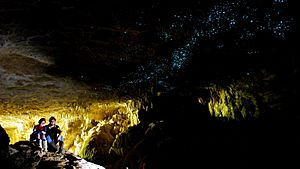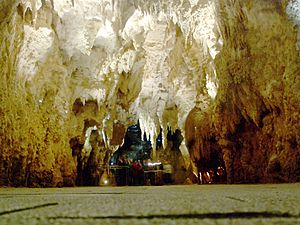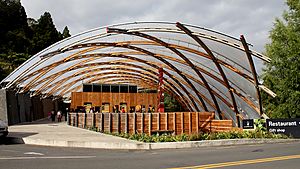Waitomo Glowworm Caves facts for kids
The Waitomo Glowworm Caves are a super cool cave system in Waitomo, New Zealand. These caves are famous for their unique glowworms. These special glowworms, called Arachnocampa luminosa, are only found in New Zealand. The Waitomo streamway system includes other caves like Ruakuri Cave.
At the entrance, there's a modern visitor center mostly made of wood. You can join organized tours that include a fun boat ride right under the glowing worms!
Contents
Discovering the Waitomo Caves
The name "Waitomo" comes from the Māori words wai, meaning water, and tomo, meaning hole or shaft. Local Māori people knew about the caves for a long time. In 1884, a local Māori man named Tane Tinorau and two English surveyors, Laurence Cussen and Fred Mace, were shown the entrance.
Tane and Fred explored the caves a lot in 1887 and 1888. They used candlelight and a raft to go into the cave where the stream goes underground. This is now the cave's exit for tourists. As they floated in, they saw the Glowworm Grotto. They were amazed by the twinkling lights on the ceiling! As they went deeper, they were also stunned by the limestone formations. These formations were all around them in many shapes and sizes.
Tane Tinorau later found the upper entrance to the cave by himself. This is the entrance used today. More visitors could come when the railway reached Otorohanga in 1887. By 1889, Tane Tinorau and his wife Huti opened the cave to visitors. They led groups for a small fee.
The government took over the caves in 1906 because of damage. In 1910, the Waitomo Caves Hotel was built to host the many visitors. In 1989, the land and cave were given back to the descendants of Chief Tane Tinorau and Huti. Many of them work at the caves today. They get a part of the cave's earnings and help manage it.
How the Caves Were Formed
The Waitomo region has about 300 known limestone caves. These caves were created by geological and volcanic activity over the last 30 million years.
The limestone in the Waitomo Glowworm Caves formed when the area was under the ocean. This was about 30 million years ago. The limestone is made of fossilized corals, seashells, fish skeletons, and tiny sea creatures. Over millions of years, these fossilized rocks piled up. They were pressed together to create limestone. In the Waitomo area, this limestone can be over 200 meters thick.
The caves started to form when the earth moved. This caused the hard limestone to bend and rise above the sea floor. When the rock was exposed to air, it cracked. Water then flowed through these cracks, dissolving the limestone. Over millions of years, large caves were formed this way.
The amazing stalactites, stalagmites, and other cave formations grew from water dripping from the ceiling. They also formed from water flowing over the walls. This water left behind limestone deposits. Stalagmites grow upwards from the floor. Stalactites grow downwards from the ceiling. When these formations connect, they are called pillars or columns. If they twist, they are called helicti. These cave decorations take millions of years to form. An average stalactite grows only one cubic centimeter every 100 years!
Animals of the Caves
The most common animals in the caves are insects. This includes albino cave ants and giant crickets. But the most famous is the glowworm Arachnocampa luminosa. Adult glowworms are about the size of a mosquito. There are also small underground lakes. These lakes are home to New Zealand longfin eels.
The cave walls also have different types of fungi. One is called the cave flower. It is a mushroom-like fungus.
Keeping the Caves Safe
The glowworms in the Waitomo Glowworm Caves are carefully protected. A Scientific Advisory Group watches over them. This group uses special equipment. It constantly checks the air quality, especially carbon dioxide levels. It also monitors rock and air temperature, and humidity. Experts carefully look at this information.
The advisory group uses this data to decide how to manage the cave. They figure out if and when air flow patterns should change. They also decide how many people can visit the caves each day. This helps keep the glowworms and the cave healthy.
Your Guided Tour Experience
The guided tour through the Waitomo Glowworm Caves takes you through three different levels. It starts at the top level of the cave in an area called the Catacombs. The levels are connected by the Tomo. This is a 16-meter vertical shaft made of limestone.
The second level is called the Banquet Chamber. Early visitors used to stop here to eat. You can still see smoke on the ceiling from their fires! From here, you might be able to go back to the upper level. This is to see the largest formation called the Pipe Organ. However, on busy days, this area is closed. Too much carbon monoxide can build up, which is not safe.
The third and final level goes down into the Cathedral. This is a large, enclosed area. It is about 18 meters high. This makes it have really good acoustics. Many famous singers and choirs have performed here, including Dame Kiri Te Kanawa.
The tour ends with a boat ride through the Glowworm Grotto. The boat takes you onto the underground Waitomo River. The only light comes from the tiny glowworms. They create a beautiful sky of living lights above you!
Where to Find the Caves
The Waitomo Glowworm Caves are in the Northern King Country region of New Zealand's North Island. They are about 12 kilometers northwest of Te Kuiti. The caves are about 2 hours south of Auckland by car. They are also 1 hour south of Hamilton and 2 hours west of Rotorua.
To get there, exit State Highway 3 onto Waitomo Caves Road. Then, continue on this road for about 8 kilometers.




